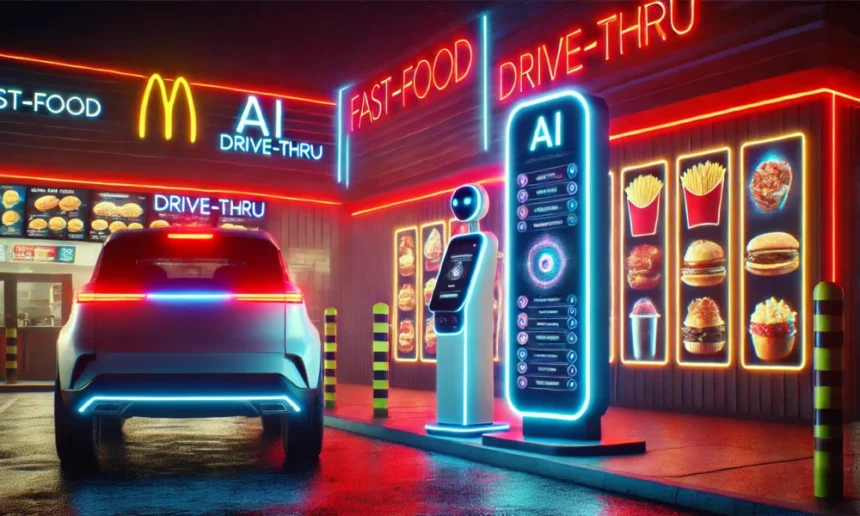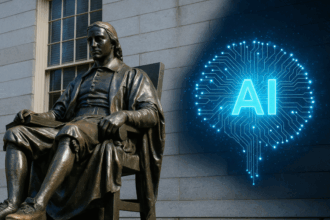The fast food industry is evolving and technology is at the heart of this transformation. Wendy’s has teamed up with Google Cloud to introduce Frashai, an AI-powered ordering system designed to make drive-through services faster, more accurate and more efficient.
This innovation goes beyond convenience, aims to enhance order experiences by reducing errors, streamlining services, and personalizing interactions. With artificial intelligence (AI) handling more processes, fast food chains can serve their customers more efficiently than ever before.
As AI becomes more integrated into the industry, it is redesigning how orders are placed and processed. It also changes employee roles and customer interactions while improving efficiency and accuracy. This transformation marks the beginning of a new era of fast food, where automation and technology play a bigger role in everyday operations.
The rise of AI in fast food chains
Major fast food chains such as McDonald’s, Taco Bell and KFC are actively experimenting with AI to improve service speed and order accuracy. However, the Wendys lead the race with Frashai, an AI-powered drive-through system.
Wendy’s drive-through sales account for nearly 70% of total revenue, making it a major area of automation and optimization. AI can efficiently process voice orders, process payments, and propose add-ons while minimizing human error. This not only speeds up service and improves accuracy, but also reduces latency and improves the overall customer experience by providing personalized interactions.
AI integration in fast food offers several important benefits. By automating routine tasks, AI can help staff focus on more important aspects of customer service and improve overall efficiency. AI-driven analytics also help restaurants understand customer preferences, optimize menu offerings, and reduce food waste that contributes to both profitability and sustainability.
With the sustained advances in AI, fast food chains are moving towards a more personalized and efficient dining experience. AI-powered systems can better predict customer preferences, streamline kitchen operations and optimize supply chains than traditional methods. This conversion is not only efficient. It’s about increasing customer satisfaction and loyalty by providing a seamless, contactless experience.
Wendy’s AI-driven drive-through system (Frashai)
Frashai uses advanced natural language processing (NLP), machine learning (ML), and generator AI to optimize your fast food ordering experience. Frashai enhances order speed, accuracy and personalization, setting new benchmarks for AI-driven automation at Quick Service Restaurants (QSR).
Unlike traditional speech recognition systems, Frashai employs a deep learning model trained in the interactions of thousands of real-world customers. These models allow you to process complex orders, handle customizations, and understand a variety of audio patterns, including a variety of accents, dialects, and colloquial phrases. AI continuously improves accuracy through a real-time feedback loop, improving performance with each interaction.
Main features and technical features
Real-time AI-equipped voice ordering
Frashai uses speech-to-text (STT) and text-to-speech (TTS) models optimized for fast, low-latency interactions. The system transcribes customer speeches, processes requests using context-aware NLP algorithms, and generates dynamic responses with close-to-human conversational flow ency. Unlike traditional rule-based ordering systems, Frashai transformer-based models can handle interruptions, out-of-order commands, and changes in the middle of a transformation.
Fast order processing and improved efficiency
By automating the ordering process, Frashai reduces the average order time by approximately 22 seconds, allowing each drive-thru location to process orders per hour. AI can handle multiple customer requests in parallel, reducing bottlenecks during peak times.
Advanced ordering accuracy with ML-driven customization processing
Frashai achieves an industry-leading order accuracy of around 99%, minimizing false orders and operational inefficiencies. Use neural network-based entity recognition to accurately map voice requests to menu items, even when customers are using ambiguous phrasing or slang. AI’s intention recognition model detects changes and updates the order accordingly, reducing the need for manual modifications.
Comprehensive multilingual support
Frashai supports both English and Spanish, serving a diverse range of customer demographics. AI dynamically switches languages based on customer inputs, ensuring bilingual interactions without the need for manual selection. This multilingual feature is particularly important for Wendy’s locations in multicultural and dense urban areas.
Multimodal interaction via digital menu board
Beyond audio-based interactions, Frashai integrates with a digital menu board to enable real-time visual order confirmation. Customers can see their on-screen choices before proceeding to payment and reducing errors and disputes. This multimodal AI interface combines audio and visual feedback for a more intuitive ordering experience.
Cloud-connected AI for continuous learning and optimization
Frashai runs on Google Cloud’s Vertex AI infrastructure, enabling scalable deployment, continuous model retraining, and centralized data management. The key benefits are:
- Edge AI Processing: Minimize latency by locally handling customer requests while synchronizing cloud insights.
- Federated Learning Models: Frashai learns from anonymized data in multiple locations, improving response accuracy without compromising privacy.
- Dynamic Menu Adaptation: AI-driven analysis adjusts menu recommendations based on time, location and seasonal trends.
Strategic expansion and future AI integration
Wendy’s is preparing to bring Frescia to more than 500 locations by the end of 2025, making it one of the biggest AI rollouts in the fast food world. The move is to order faster, easier and more seamlessly, whether customers use drive-throughs, self-service kiosks or mobile apps.
Wendy’s has some very interesting plans, including upselling with AI. Here, the system proposes menu items based on what customers like, revives integration with loyalty programs, recognizes guests and offers personalized deals. Computer Vision AI could even help you manage your drive-thru route racing by tracking your car in real time, reducing wait times and making things run smoothly. As AI continues to evolve, Wendy’s uses smart technology to improve speed, accuracy, and overall customer experience.
The Benefits of AI in Drive-Thru Orders
AI-powered drive-through systems like Frashai are changing the fast food experience by making orders faster, more personalized and more efficient.
One of the biggest advantages is faster service and shorter latency, especially during peak hours when long lines can be frustrating. Unlike traditional ordering methods, AI can process multiple orders at once, reducing bottlenecks and keep things running smoothly.
Beyond speed, the customer experience also receives a huge boost. For example, Frashai can recognize customers returning customers and easily handle complex changes and meal needs while suggesting menu items based on past preferences.
Business-wise, AI provides cost-effectiveness and scalability, enabling restaurants to streamline operations and reduce labor costs without sacrificing the quality of their services. With its ability to expand to hundreds of locations, AI-powered ordering systems are becoming a game changer for major fast food brands, aiming to improve efficiency and customer satisfaction.
Customer reactions and industry trends
AI-powered drive thrus is becoming more common in the fast food industry, but not everyone is taking part. Wendy’s Frashai receives a variety of feedback. While some customers appreciate the increased accuracy and reduced order errors, many have encountered problems. Complaints include interruptions during orders, difficulty in custom requests, and understanding various accents. There are also concerns about accessibility, especially for people with language disorders.
Other fast food chains are also investigating AI. McDonald’s is testing its own AI drive-through system, but faces similar issues with voice recognition. Taco Bell has introduced AI-powered kiosks for in-store orders, demonstrating how the industry is moving forward with automation despite the ongoing challenges.
The role of AI in fast food is not limited to ordering. Many companies are investing in AI chatbots to handle customer service, and robotic kitchen assistants are reducing waste by improving food preparation and more accurately predicting AI-driven inventory management.
AI still has a long way to go, but major fast food chains are working on improving their technology. Once improvements are made, AI could play a major role in making fast food more efficient and consistent.
Issues and concerns about AI in fast food
AI Drive Thrus has distinct advantages, but it also brings a significant portion of the challenges. Systems like Wendy’s Frashai are designed for accuracy, but struggle with background noise, multiple voices, complex or severely customized orders. Customers with strong accents or those using slang can also encounter problems, leading to frustration rather than convenience.
Beyond technical concerns, not everyone is comfortable ordering from the machine. Some customers prefer the personal touch of human employees, especially when making special requests. There is also a level of distrust as some people feel uneasy about AI processing orders and personal data.
The impact on jobs is another major concern. While companies claim that AI is intended to support workers rather than replace them, fears remain about automating employment opportunities in the fast food industry.
Furthermore, data privacy issues can be a major concern. AI systems such as Frashai collect and process customer voice data and raise questions about how that information is stored and used. As AI becomes more common in fast food, it is important to ensure strong security measures and compliance with privacy regulations.
Conclusion
AI steadily transforms the fast food industry, offering faster service, improved accuracy and increased efficiency. Wendy’s Freshear exemplifies both the promises and challenges of this development. Automation streamlines orders and enhances personalization, but also raises valid concerns about work movement, data privacy and accessibility.
These challenges need to be addressed in the future to ensure a seamless and comprehensive experience for all customers. The future of fast food can be imagined as a great combination of technology and human interaction.









